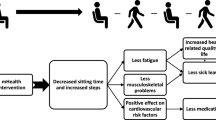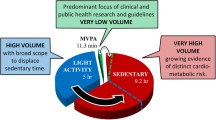Abstract
Breaking up sitting time with light- or moderate-intensity physical activity may help to alleviate some negative health effects of sedentary behavior, but few studies have examined ways to effectively intervene. This feasibility study examined the acceptability of a new technology (NEAT!) developed to interrupt prolonged bouts (≥20 min) of sedentary time among adults with type 2 diabetes. Eight of nine participants completed a 1-month intervention and agreed that NEAT! made them more conscious of sitting time. Most participants (87.5 %) expressed a desire to use NEAT! in the future. Sedentary time decreased by 8.1 ± 4.5 %, and light physical activity increased by 7.9 ± 5.5 % over the 1-month period. The results suggest that NEAT! is an acceptable technology to intervene on sedentary time among adults with type 2 diabetes. Future studies are needed to examine the use of the technology among larger samples and determine its effects on glucose and insulin levels.



Similar content being viewed by others
References
Dunlop D, Song J, Arnston E, et al. Sedentary Time in U.S. Older Adults associated with disability in activities of daily living independent of physical activity. J Phys Act Health. 2014.
Patel AV, Bernstein L, Deka A, et al. Leisure time spent sitting in relation to total mortality in a prospective cohort of US adults. Am J Epidemiol. 2010; 172(4): 419-429.
Grontved A, Hu FB. Television viewing and risk of type 2 diabetes, cardiovascular disease, and all-cause mortality: a meta-analysis. JAMA. 2011; 305(23): 2448-2455.
Chomistek AK, Manson JE, Stefanick ML, et al. Relationship of sedentary behavior and physical activity to incident cardiovascular disease: results from the Women’s Health Initiative. J Am Coll Cardiol. 2013; 61(23): 2346-2354.
Bankoski A, Harris TB, McClain JJ, et al. Sedentary activity associated with metabolic syndrome independent of physical activity. Diabetes Care. 2011; 34(2): 497-503.
Sisson SB, Camhi SM, Church TS, et al. Leisure time sedentary behavior, occupational/domestic physical activity, and metabolic syndrome in U.S. men and women. Metab Syndr Relat Disord. 2009; 7(6): 529-536.
Hu FB, Li TY, Colditz GA, et al. Television watching and other sedentary behaviors in relation to risk of obesity and type 2 diabetes mellitus in women. JAMA. 2003; 289(14): 1785-1791.
Lynch B, Dunstan D, Healy G, et al. Objectively measured physical activity and sedentary time of breast cancer survivors, and associations with adiposity: findings from NHANES (2003–2006). Cancer Causes Control. 2010; 21(2): 283-288.
Wilmot EG, Edwardson CL, Achana FA, et al. Sedentary time in adults and the association with diabetes, cardiovascular disease and death: systematic review and meta-analysis. Diabetologia. 2012; 55(11): 2895-2905.
Healy GN, Dunstan DW, Salmon J, et al. Objectively measured light-intensity physical activity is independently associated with 2-h plasma glucose. Diabetes Care. 2007; 30(6): 1384-1389.
Healy GN, Wijndaele K, Dunstan DW, et al. Objectively measured sedentary time, physical activity, and metabolic risk. Diabetes Care. 2008; 31(2): 369-371.
Healy GN, Dunstan DW, Salmon J, et al. Breaks in sedentary time: beneficial associations with metabolic risk. Diabetes Care. 2008; 31(4): 661-666.
Dunstan DW, Kingwell BA, Larsen R, et al. Breaking up prolonged sitting reduces postprandial glucose and insulin responses. Diabetes Care. 2012; 35(5): 976-983.
American Diabetes Association. Economic costs of diabetes in the U.S. in 2012. Diabetes Care. 2013; 36(4): 1033-1046.
Bey L, Hamilton MT. Suppression of skeletal muscle lipoprotein lipase activity during physical inactivity: a molecular reason to maintain daily low-intensity activity. J Physiol. 2003; 551(Pt 2): 673-682.
Hamilton MT, Hamilton DG, Zderic TW. Exercise physiology versus inactivity physiology: an essential concept for understanding lipoprotein lipase regulation. Exerc Sport Sci Rev. 2004; 32(4): 161-166.
Hamilton MT, Hamilton DG, Zderic TW. Role of low energy expenditure and sitting in obesity, metabolic syndrome, type 2 diabetes, and cardiovascular disease. Diabetes. 2007; 56(11): 2655-2667.
Duvivier BMFM, Schaper NC, Bremers MA, et al. Minimal intensity physical activity (standing and walking) of longer duration improves insulin action and plasma lipids more than shorter periods of moderate to vigorous exercise (cycling) in sedentary subjects when energy expenditure is comparable. PLoS One. 2013; 8(2): e55542.
Healy GN, Matthews CE, Dunstan DW, et al. Sedentary time and cardio-metabolic biomarkers in US adults: NHANES 2003–2006. Eur Heart J. 2011; 32(5): 590-597.
Levine JA, Lanningham-Foster LM, McCrady SK, et al. Interindividual variation in posture allocation: possible role in human obesity. Science. 2005; 307(5709): 584-586.
Cowie CC, Rust KF, Byrd-Holt DD, et al. Prevalence of diabetes and high risk for diabetes using A1C criteria in the U.S. Population in 1988–2006. Diabetes Care. 2010; 33(3): 562-568.
Spring B, Schneider K, McFadden HG, et al. Multiple behavior changes in diet and activity: a randomized controlled trial using mobile technology behavior changes in diet and activity. Arch Intern Med. 2012; 172(10): 789-796.
Healy GN, Eakin EG, LaMontagne AD, et al. Reducing sitting time in office workers: Short-term efficacy of a multicomponent intervention. Prev Med. 2013; 57(1): 43-48.
Carr LJ, Karvinen K, Peavler M, Smith R, Cangelosi K. Multicomponent intervention to reduce daily sedentary time: a randomised controlled trial. BMJ Open. 2013;3(10).
Gardiner PA, Eakin EG, Healy GN, et al. Feasibility of reducing older adults’ sedentary time. Am J Prev Med. 2011; 41(2): 174-177.
Evans RE, Fawole HO, Sheriff SA, et al. Point-of-choice prompts to reduce sitting time at work: a randomized trial. Am J Prev Med. 2012; 43(3): 293-297.
Smith A. Pew Internet & American Life Project: Mobile Technology Fact Sheet. 2014; http://www.pewinternet.org/fact-sheets/mobile-technology-fact-sheet/. Accessed 26 March 2014.
Freedson PS, Melanson E, Sirard J. Calibration of the Computer Science and Applications. Inc Accelerometer MSSE. 1998; 30(5): 777-781.
Matthews CE, Chen KY, Freedson PS, et al. Amount of time spent in sedentary behaviors in the United States, 2003–2004. Am J Epidemiol. 2008; 167(7): 875-881.
Dantzig S, Geleijnse G, Halteren AT. Toward a persuasive mobile application to reduce sedentary behavior. Personal Ubiquit Comput. 2013; 17(6): 1237-1246.
Neuhaus, M., et al., Reducing occupational sedentary time: a systematic review and meta-analysis of evidence on activity-permissive workstations. Obes Rev. 2014.
Kozey-Keadle S, Libertine A, Staudenmayer J, et al. The feasibility of reducing and measuring sedentary time among overweight, non-exercising office workers. J Obes. 2012; 2012: 282303.
Bond DS, Thomas JG, Raynor HA, et al. B-Mobile—a smartphone-based intervention to reduce sedentary time in overweight/obese individuals: a within-subjects experimental trial. PLoS One. 2014; 9(6): 1-8.
Cooper A, Sebire S, Montgomery A, et al. Sedentary time, breaks in sedentary time and metabolic variables in people with newly diagnosed type 2 diabetes. Diabetologia. 2012; 55(3): 589-599.
Healy GN, Clark BK, Winkler EAH, et al. Measurement of adults’ sedentary time in population-based studies. Am J Prev Med. 2011; 41(2): 216-227.
Shaw JE, Sicree RA, Zimmet PZ. Global estimates of the prevalence of diabetes for 2010 and 2030. Diabetes Res Clin Pract. 2010; 87(1): 4-14.
Helmerhorst HJF, Wijndaele K, Brage S, et al. Objectively measured sedentary time may predict insulin resistance independent of moderate- and vigorous-intensity physical activity. Diabetes. 2009; 58(8): 1776-1779.
Thorp AA, Healy GN, Owen N, et al. Deleterious associations of sitting time and television viewing time with cardiometabolic risk biomarkers: Australian diabetes, obesity and lifestyle (AusDiab) study 2004–2005. Diabetes Care. 2010; 33(2): 327-334.
Acknowledgments
This study was supported by the Chicago Center for Diabetes Translation Research (NIDDK P30 KD092949), the Dean’s office of the Biological Sciences Division of the University of Chicago, and NIDDK R01 DK097364. The authors thank Jennifer Warnick for her assistance with the qualitative analyses.
Conflict of interest
No competing financial interests exist.
Adherence to ethical principles
All procedures performed, including the informed consent process, were conducted in accordance with the ethical standards of the approving institutional review boards and with the 1964 Helsinki Declaration and its later amendments.
Author information
Authors and Affiliations
Corresponding author
Additional information
Implications
Practice: Practitioners may consider recommending breaking up prolonged sedentary bouts, particularly for those who spend the majority of the day sitting.
Policy: Policymakers should consider developing appropriate recommendations for sedentary behavior.
Research: More research is needed to further examine the role of technology in interrupting prolonged bouts of sedentary behavior and determine whether this can significantly improve biomarkers.
About this article
Cite this article
Pellegrini, C.A., Hoffman, S.A., Daly, E.R. et al. Acceptability of smartphone technology to interrupt sedentary time in adults with diabetes. Behav. Med. Pract. Policy Res. 5, 307–314 (2015). https://doi.org/10.1007/s13142-015-0314-3
Published:
Issue Date:
DOI: https://doi.org/10.1007/s13142-015-0314-3




